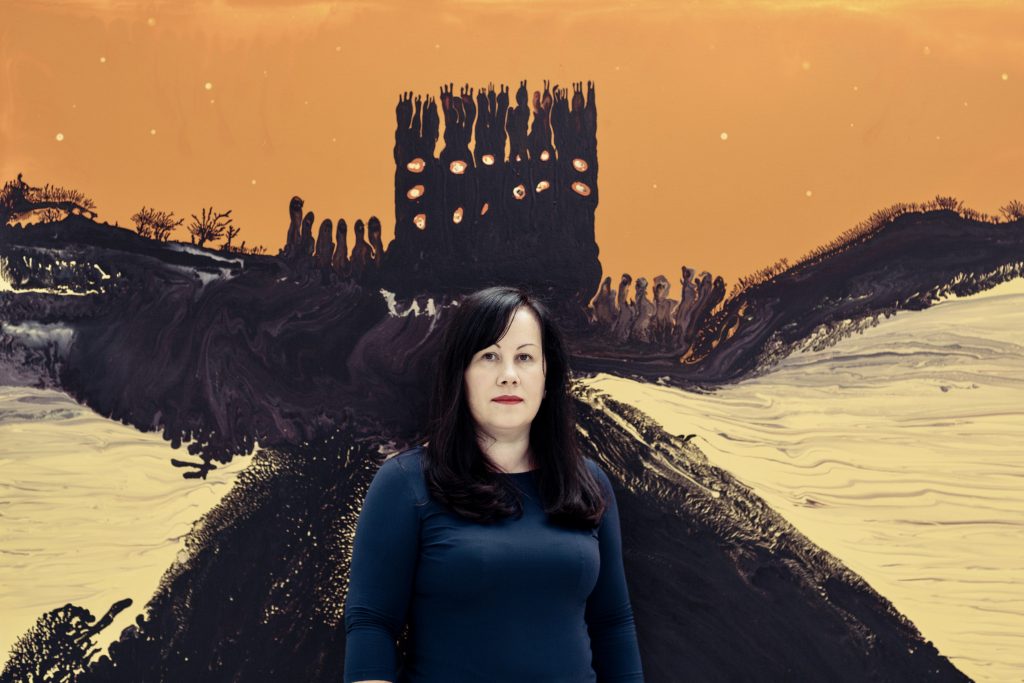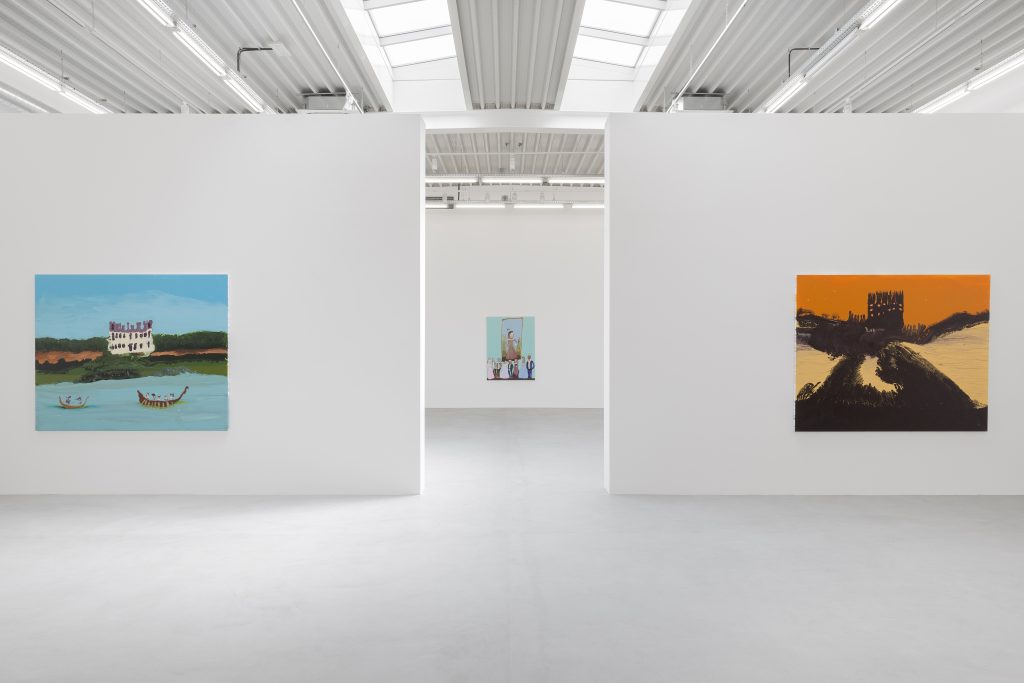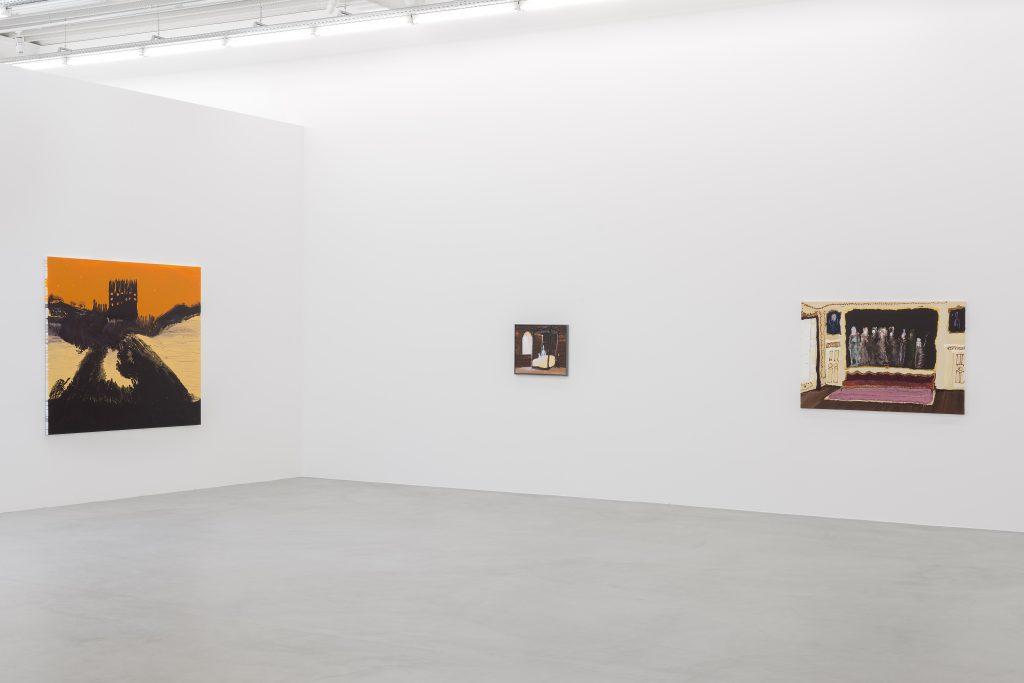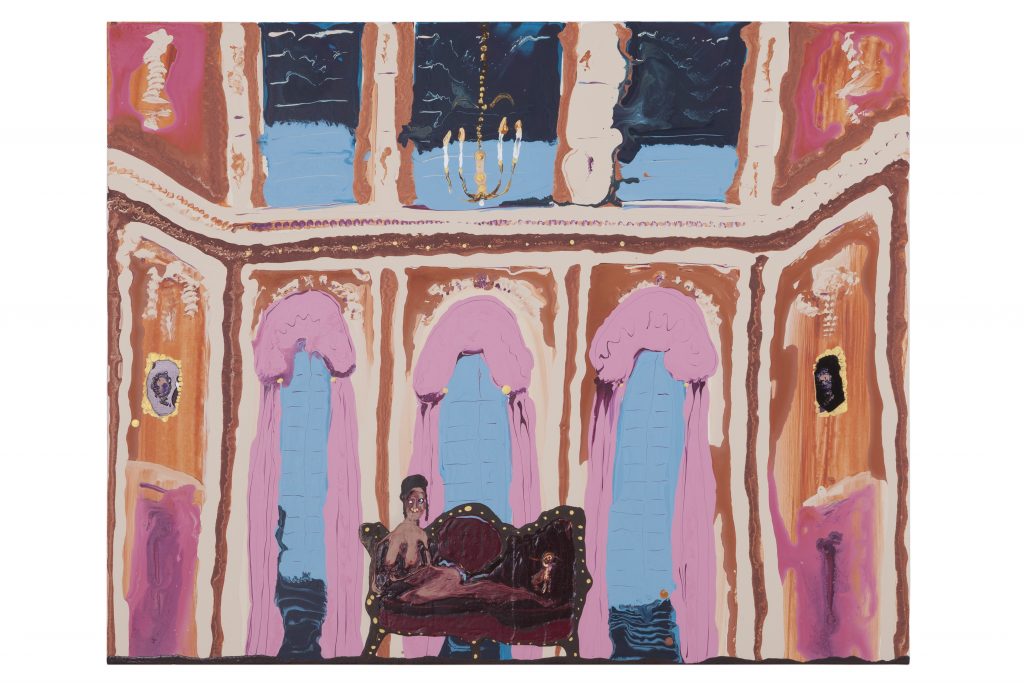“The tears of the world are a constant quantity. For each one who begins to weep somewhere else another stops. The same is true of the laugh. Let us not then speak ill of our generation, it is not any unhappier than its predecessors.”
― Samuel Beckett, Waiting for Godot
Unsettling paintings, rich and eye candy colors, and small figures that remind us of our childhood. Upon a closer look, melting through the paint, the deformed bodies and skull-like and animalistic faces are revealed. The humorous and whimsical coexists with the macabre and disquiet. History has been a constant starting point for the artist’s work – reinterpretations of Fragonard (The Swing After Fragonard, 2014), Boucher (Birth of Venus after Boucher, 2016) and Velázquez, Madame de Pompadour, Romeo and Juliet, Ensor (Ensor & friends). How do these same figures and moments in history repeat themselves masked under the different cosmetics of time? In Figgis’ paintings, these recovered moments are seen through a house of mirrors in which old times are reflected on contemporaneity – a figurative abstraction of blend and of continuous and sinuous acrylic brushstrokes.

Photography: Doreen Kilfeather
Catarina Vaz: Do you still live and work in County Wicklow? In such an idyllic place, how does nature, castles, and ruins influence your painting? Do you believe that your work would have a different trajectory if you were living in an urban landscape?
Genieve Figgis: I live in Co Wicklow in Ireland. I love it here. Love the history the landscape, the people. Everything. I have never lived in a city but I enjoy visiting all my favourite cities. Seeing the people and the museums. It’s nice to go back to home then afterwards.
CV: Internet and social media were an important platform to launch your career. Could you tell us about the curious and exciting story of the discovery of your works through Twitter and the subsequent success?
GF: I had only joined Twitter in 2012 and wasn’t really sure how it all worked. I saw Richard Prince and followed him. I knew his work and was a fan but wasn’t sure even if it was the real Richard Prince. But he followed me back and I was delighted.
He took an interest in my work and that was a wonderful feeling because it gave me more confidence. No one had ever really understood me or my work until that point.
CV: When we look at your work our senses are contradicted. We find a tragic comic irony – the grotesque is masked with docile colors and seemingly innocent figures. Do you have a critical intention?
GF: I never set out to portray grotesque or comedic in my work. This is something that happens in the process. When you look at the paintings hopefully you will see that nothing has been planned or contrived in any way. Everything happens by chance.

162,6 x 121,9 cm, 64 x 48 in.
Genieve Figgis ‘What we do in the shadows’ at Almine Rech Gallery, Brussels
© Genieve Figgis – Courtesy of the Artist and Almine Rech Gallery
CV: Why are you fascinated with historical themes and historical paintings?
GF: History was a subject that allowed me to travel off in my daydreams during school. It was a very enjoyable experience for me. So when I’m reading a book I usually choose an historical theme also. I want to travel and I want to learn.
CV: Do you often work on series (such as Romeo and Juliet) or do you pick different subjects at the same time?
GF: The Romeo and Juliet was made for The Met Opera in New York. Opera is something that I find incredibly exciting and so I had made the work for Romeo and Juliet to coincide with the stage production.
CV: Do you think about a group of works as a construction of a narrative (anytime during your process) and, if so, do you visualize a possible interaction or order when the works are installed?
GF: I use my work to explore worlds that are unavailable to me. Just to experience the feeling of being somewhere more beautiful. I do like to have control of how the show is installed and that is also part of the process for me.

© Genieve Figgis – Courtesy of the Artist and Almine Rech Gallery – Photo: Hugard & Vanoverschelde Photography
CV: The title of your new show at Almine Rech (‘What We do in The Shadows’) is pretty much introductory to the ideas found in your work – in a formal way they are apparent naive figures whose melting faces and bodies are dissolved in each other and in the backgrounds, while in a conceptual way we find the representation of bourgeois figures proudly fancying their richly adorned properties.
On the one hand there is a sense of property – the castle, the luxurious household, the women – on the other the portrait and pomposity. It all leads to the idea of staging and mise-en-scène. All and all, the world is a stage. This stage has been often recorded in history. Were you thinking about fabricating moments of intimacy lost in the shadows of history?
GF: The melting in the paint that you see allows me to invent and direct as I go along. The painting is a stage but it’s also working like it has no script. The story is made up impromptu with no idea of how it will end.
The women in the paintings are reinventions of historical portraits. I like to paint them as more vibrant characters, braver more colourful and alive.
CV: Returning to the idea of mise-en-scène, does theater have any influence on your work and do you paint and manipulate your figures as characters in a play?
GF: Yes. When I was growing up I attended drama classes. Putting on plays and making costumes was a big part of my life.

© Genieve Figgis – Courtesy of the Artist and Almine Rech Gallery – Photo: Hugard & Vanoverschelde Photography
CV: Some of your works portray these darling ladies posing with their miniature dogs. Dogs were always present in the history of painting, often in portraits or in hunting scenes. Though here, the dog in its wee minuscule size appears harmless near the distorted faces of the figures. Is the dog a mere formal choice in your painting?
GF: When we look back on some of the old masters there is usually a dog or two and various animals. They seem to have way more knowledge than the humans. In my work I like to stick them in beside the figures because I have four dogs and I am totally obsessed with them. I like to see animals in paintings because it seems very normal and they make me happy.

Acrylic on canvas, 80 x 100 x 4 cm, 31 1/2 x 39 3/8 x 1 5/8 in
Genieve Figgis ‘What we do in the shadows’ at Almine Rech Gallery, Brussels
© Genieve Figgis – Courtesy of the Artist and Almine Rech Gallery
CV: Could you tell us about one of the favorite shows you visited recently?
GF: My most recent exhibition that I enjoyed: Bruegel. Unseen Masterpieces at the Royal Museums of Fine Arts of Belgium.
CV: Can you share with us one of your favorite books?
GF: I like The Witching Hour by Anne Rice.
CV: Do you consider that Internet, social media, and websites like Art Research Map are important to promote established artists and help launch the careers of emerging artists?
GF: Yes of course. The internet is where we can all share stories, music and art. I love to see what other artists are doing. It is impossible to travel and see all the shows.
by: Catarina Vaz, June 2017
